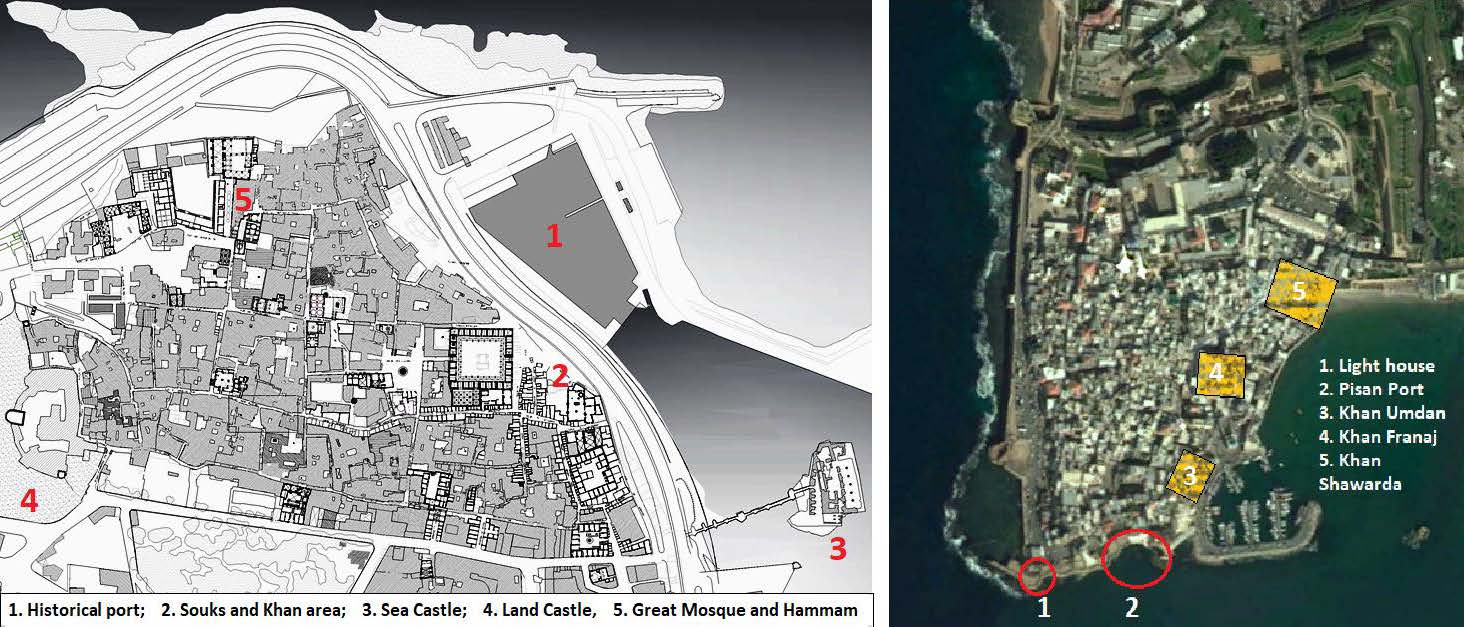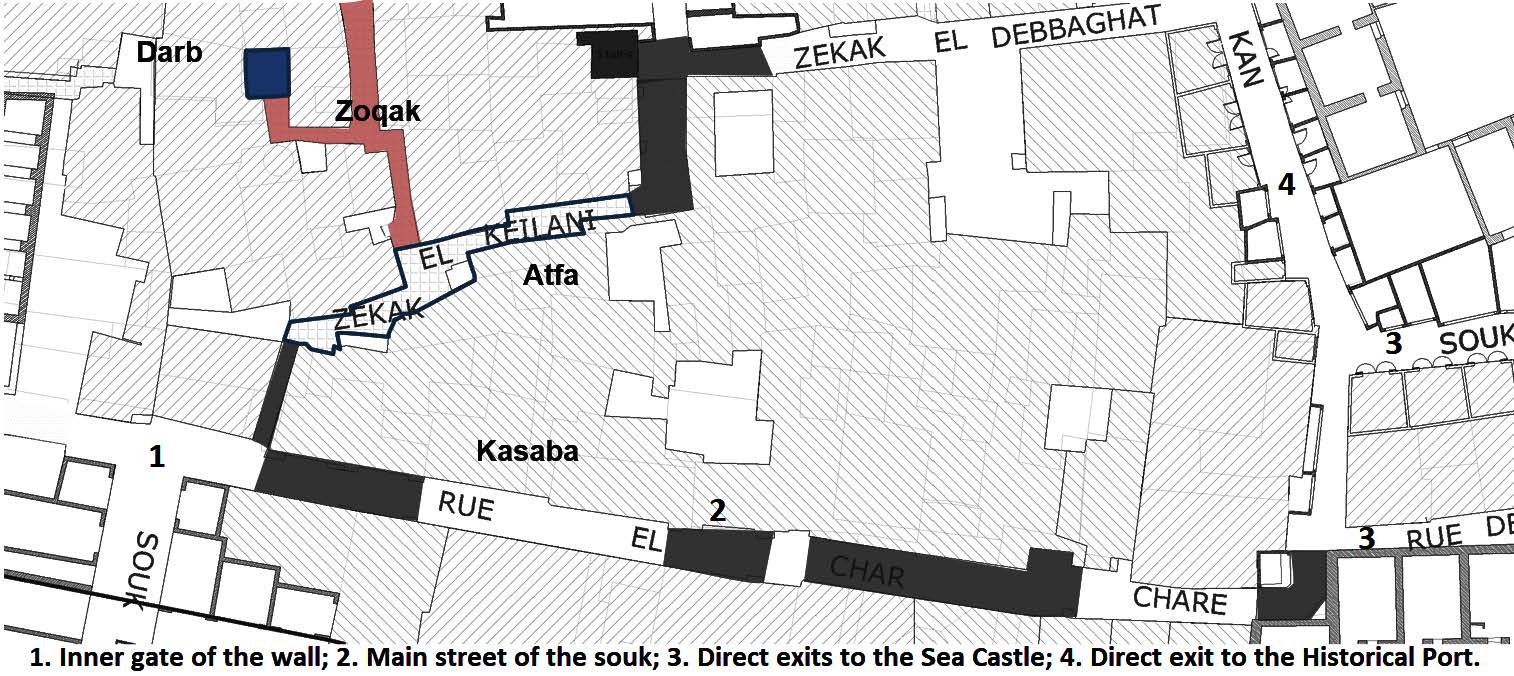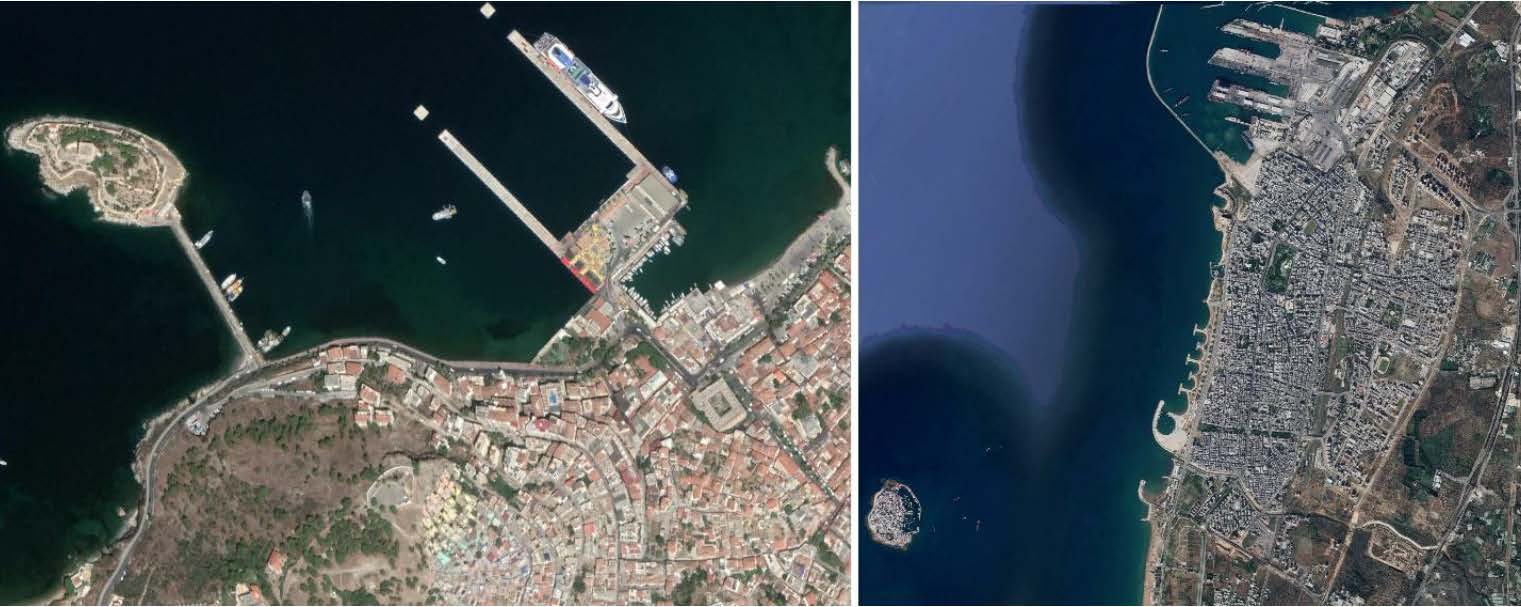This article is an introduction to the heritage topic in the Eastern Mediterranean ports. It is an opportunity for a general reflection to overview the main topics and circumstances that are converging on these ports and especially the relations between them and their respective cities.
Heritage is a co-substantial element to the Mediterranean´s own existence. The heavy weight of History has deposited significant layers of heritage footprints that clearly define a sign of identity for the whole Mediterranean region.
This fact has played an important role in the case of Eastern Mediterranean region, due to different reasons:
- The regional cultural crossroad, as historical phenomenon, is more evident because most of the major religions were born there. The production of historical and architectural references was multiplied.
- As an apparent contradiction, the conflict territories produced alongside the region an important arousal of ruins and a direct consequence of it was a continuous reconstruction process, provoking overlapped layers sharing the same spaces.
- The fact of shipping activities being displaced to North Europe [1] has facilitated a progressive stagnation of port activities, generally reduced to a local level till the Suez Canal aperture in 1869.
As a direct consequence of it, recycling of ruins, overlapping structures and reusing previous typologies became a part of continuous acculturation processes. In fact, important exoduses happened during History that implied overlapped historical layers. In addition, conflict territories have a common characteristic: the intention of branding territories as a footprint of their respective territorial controls, able to survive, at least, till next editions of local or regional conflicts.
Heritage, because of the above reasons, must be considered as a crucible of activities, an amalgam of overlapped functions where the strategic location of cities implied a parallel development of ports, successfully named “cities of commerce” [2].
Historical Ports and commercial typologies
Mediterranean fluxes along the History were in both senses too, either from eastern regions to western ones or in the opposite way. This pendular movement favored the arousal of so many new ports and cities from so different origins. The cultural superposition comes from these movements and the island of Cyprus is a good example for that: Persians, Greek, Romans, Byzantines, Lusignan, Crusaders, Genoese and Venetian merchants, as well as Ottomans, and British contributed for this palimpsest of cultures and the respective parallel territorial and urban interpretations.
Different architectural and urban typologies were associated to those fluxes. The commercial activities needed the creation of common conceptual space with different names, depending of the regions: all these typologies were structured around a central spatial organization, close to port activities or even physically linked to the water existence (see the following image).
Typological evolution of commercial buildings. (Composed by the author)
All the Islamic cities were especially branded by this market vision and their contributions to the commercial typologies were a continuous evolution, starting with the funduq, passing through the wakala (Egypt) and Khan (Syrira) and finally caravansarais promoted and developed by various cultures: Ayyubids in Syrian, Seljuks in Iran-Anatolia, Ilkhandi or Safarids in Otoman Empire. The fondaco, was, in the end, the typological answer provided by western European cultures.
All these facts configure a spread of Heritage elements linked indifferent ways and intensities with the port. Eastern Mediterranean heritages must be considered under different perspectives when compared with the European port-cities. In this case heritage elements are usually mixed, not being a clear separation between port and urban realities, and consequently, heritages. Historical regional evolution favored the fact of most of the historical ports´ scales being preserved till nowadays except in the case of an exponential growth of the port activities. The ports of Acre and Saïda, as important references in the regional commercial fluxes, reflect clearly these symbiosis between ports and cities through these architectures (see the following image).
Historical relations between port and cities through commerce typologies. (Composed by the author, Based on Saïda Plan (by author) and Carto aerial picture (carto.com))
Ports expansions during 19th century
Only a few ports and their respective cities grew up to what could be named a major scale. Piraeus-Athens, Alexandria and Constantinople-Istanbul can be considered as historical port-cities of bigger scale. A common characteristic of these port-city scales is the fact that some locations are characterized by a continuous port expansion, translated into important land consumption [3]. The way these ports grew up was not conceived through the elaboration of a comprehensive master plan. Growing steps were not apparently interconnected. Heritage elements, in these cases, arose as isolated objects without real physical interconnections.
A second generation of ports assumed certain scale during the 19th century strongly related to Suez Canal [4]: Port Said-Port Fouad, Izmir, Mersin, Beirut and Larnaca. These port-cities were an exception, a port network was formed for the first time around such phenomenon: the arousal of Suez Canal. Most of the eastern Mediterranean ports were within the medium-small scale, with important cultural fluxes. The identity signal of the region would it would be based on the establishment of an intense network of local naval traffic with multiple possibilities of liaison and scarce relations outside the Mediterranean basin. This fact would support the idea of the medium-small port-cities.
The smaller the city is, the bigger existence of urban heritage pieces inside the respective port cities.
Eastern port-cities typologies were historically reflecting different urban patterns, as the result of traces deposited on them by the successive societies humanized these territories. In fact, it is obvious that these port-cities were following different urban codes caused by converging opposite uses of public spaces on the same urban scenarios. These differences were based on the way how different co-existent communities use them.
Mediterranean Port-cities and Heritages: A tentative classification
Most of the eastern Mediterranean cities are characterized by Muslim urban patterns. The sequence of the streets is based on the connections between Kasaba (main street) and Darb, as the minimal expression of public spaces where its privatization of public spaces is done in different ways. Intermediate spaces, between public and private ones, have more important and different meanings in this culture. These facts are more evident in the connections between cities and its ports, through public spaces shared in different levels. These questions are visible in the urban patterns of Saïda (see the following image). This situation was kept in the region till the institutionalization of the port spaces through the creation of Entities, which were assigned as territorial managers of the port areas. A recent privatization process happened during the last decade, especially alongside the Turkish coastline.
Urban hierarchy in Saïda walled city- Relation with the port. (By the author)
A tentative classification of heritage realities is proposed. Coming from a first general analysis:
- The landscape scale, as an important environmental parameter.
In this case the heritage value is coming from the coincidence among ports, urban forms and scales. This factor is highly important in small historical ports where landscapes and skylines play an important role, as a territorial branding. We can differentiate two subtypes of landscapes: the cases where the skyline includes a insertion of an element in front of the port city (cases of Tartus vs. Arwad and Kuşadası vs. Güvercinada, as per following image) and the case where the landscape is the own port city, because of its closed morphology, as usually happened in the natural ports configurations (case of Girne).
Landscape heritage in the cases of Arwad and Güvercinada. (Composed by the author, based on aerial pictures of Google Earth)
- Urban heritage elements located within the port areas.
Heritage pieces are settled as references of territorial control´s purposes, mainly built by the different cultures: Roman, Egyptian, Greek classic, Crusaders, Genoese, Venetians, Ottomans and more recently as territorial landmarks for the British and French colonizers. Most of them are defensive structures, linked to a hill city or a strategic port-city.
- Heritage elements directly related to port activities.
Different categories are defined:
(a) Full port configurations remaining till nowadays. These are the cases of the docks and piers in ports like Chania, Heraklion, Rethymo, Arwad, Byblos and Tyre in ancient time, or the remains of Industrial Heritage of the two port installations in Lefke, Northern Cyprus. These cases are rare in the general context of this region (see the following image).
Heritage port structures in Chania, Heraklion and Rethymo. (Composed by the author based on aerial pictures from carto.com)
(b) Historical elements, divided in two categories, archaeological and architectural. The first one shows diverse remains of structures, like watch towers (Lamboussa in Northern Cyprus). The second one refers to important functional activities related to the specialization of this port. That is the case of Spinalonga, in front of Plaka, in Crete.
A group of reused buildings spread all over the region with interesting rehabilitations from a functional perspective (Chania port store houses and Arsenal of the Venetian port of this city) or reassigned functions, like museological role (carob houses and the Sea Castle in Girne-Cyprus- figure 06), or centers for specific cultural activities (Governor´s house in Megalo Arsenali in Chania-Crete transformed into The Mediterranean Architecture Centre -KAM).
Heritage structures in the historical port city of Girne-Kyrenia. (Composed by the author based on aerial picture from carto.com)
Different aspects about reusing the port structures are to be highlighted in this general overview:
- Only a few historical ports in the region keep a reasonable level of commercial port activities.
- Irruption of scales is a very important aspect to be considered as a threat (menace, in peril?). The main problems come today from the arousal of the cruisers activities, growing in an exponential ways in the last decade, and the transformation of the dismissed port areas in ports like Larnaca in the Southern Cypriot coast line.
Conclusions
The above mentioned reinforces the idea of Easter Mediterranean port cities heritages having enormous potentials. However, it is clear that these potentials are not accompanied by the same number of facts, when we talk about their re-generation.
- Port heritages are present in eastern Mediterranean region in a lower level than the conventional regional port heritages. The conflict territories character, as well as certain culture of renewal without a conscience for preserving these structures, have led us to this statement.
- Port-city heritages are in all the cases main actors of the respective skylines. They play a double role as a group scale and as single elements.
- An regional inventory of heritage elements is needed where the objects assume a role as parts of a complex. Ports became hubs recipients and/of the diverse human activities.
- Mediterranean historical ports configure a network that justifies a coordinated action to recover memories and heritages, as basic identity signals to understand the origins of the Mediterranean region. Institutions like Union for Mediterranean may assume this initiative and funds can be canalized through Euromed programs of European Union.
This block of articles constitutes a vision of different aspects of the historic ports of Eastern Mediterranean region. The main ports of the Turkish coastline experimented important transformations that didn’t take into consideration the heritage aspects, as revealed by Tülin Selvi and Tolga Ünlü. The hope for recovering the memories is only possible to do through the small scales port cities where the direct relation between ports and cities is more evident. The article signed by Ahmed Ades shows the potentials of the region, especially such areas where the binomial between ports and cities reflects its parallel development, like Suez Canal. These potentials are the future and maybe last opportunities to preserve the heritage aspects in the big ports of this region. As a last conclusion we would remark that port heritages in the region are today visible in the middle and small dimension cases and they deserve all the support for its preservation.
Notes
[1] Rotterdam assumed an important role in shipping activities, together with other Dutch ports when the discovery of the sea route to the Indies during 17th century.
[2] This term is successfully used by Kolluoğlu B. and Toksöz, M. in the introductory chapter of “Cities of the Mediterranean. From the Ottomans to the present day”.
[3] According to Hastaoglou-Martinidis, V. all these port structures grew up through important landfills. Alexandria work expansions were based of a 67.6Ha landfill done in two steps, meanwhile Piraeus and Istanbul ports grew up in a minor dimension: 17 and 16 Has respectively. Data taken from her chapter “The cartography of Harbor construction in Easterm Mediterranean Cities: Technical and Urban Modernization in the late Nineteenth century” in Kolluoğlu and Toksöz (2014), on page 95.
[4] In fact, the Chief Engineer of Suez Canal was involved in the expansion works of the port of Alexandria (1870-1880) as well as designer of Pireaus new port (1882-1893). Other engineers were involved in more than one work. These are the cases of Policarpo Vitalli, author of the projects of Izmir(1868) and Salonica(1870) and Hilarion Pascal, with projects in Istanbul (1873) and Salonica (1874).
References
Abulafia, D. (2011) The Great Sea: A human History of the Mediterranean,London,Penguin.
Hastaoglou-Martinidis V (2011) The cartography of Harbor construction in Easterm Mediterranean Cities: Technical and Urban Modernization in the late Nineteenth century in Kolluoğlu and Toksöz (2014), pp.78-99.
Hastaoglou-Martinidis V (2017) Historic Harbors of Eastern Mediterranean Cities:The Challenges of Enhancement, in Porfyriou H and Sepe M (eds) Waterfronts Revisited, Routledge, Oxon.
Kolluoğlu, B. and Toksöz, M. (eds) (2014) Cities of the Mediterranean from the Ottomans to the present day, London, Tauris.
Papakonstantinou, Thomas (2014)Culture, education and history in the prefecture of Chania (1900-1901) PhD thesis, Πανεπιστήμιο Ιωαννίνων. Σχολή Επιστημών της Αγωγής. Παιδαγωγικό Τμήμα Νηπιαγωγών, in http://olympias.lib.uoi.gr/jspui/handle/123456789/28028, retrieved on 2019-02-19.
Head Image: Heritage port structures in Chania. (Aerial pictures from carto.com)





